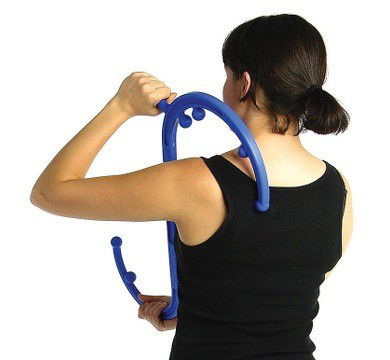Your Sydney CBD & Waterloo chiropractor enjoys working with those suffering chronic & acute neck pain, even when other therapies have failed. Neck pain is the fourthleading cause of disability, with an annual prevalence rate exceeding 30%. Most episodes of acute neck pain will resolve with or without treatment, but nearly 50% of individuals will continue to experience some degree of pain or frequent occurrences (1). Neck pain is multi factorial, some factors that are involved include extended sitting times, poor posture such as forward head carriage, sleeping on one’s stomach, stress, a general lack of exercise, trauma to the area such as whiplash etc…
Myofascial trigger points, which are hyper irritable taught bands of contracted muscles are commonly associated with chronic neck pain & headaches when looking at the pain producing structures in the neck, shoulder & head. In this article I will go through some self help techniques to help prevent the formation/re-occurrence of trigger points that I often recommend to my patients with neck pain & headaches.


To get to those ‘hard to reach places’, the tool I recommend is the Back Body Buddy (www.bodybackbuddy.com.au). This tool is ideal for the upper back, neck and shoulders such as the trapezius, levator scapula & neck muscles muscles (see diagrams below), which research has shown that people suffering with neck pain & headaches have a much higher incidence of these trigger points and also show a correlation between the amount of trigger points in these muscles and pain levels when compared to people without neck pain and/or headaches (2-4). It is also worth noting, degenerative joint disease (arthritis) of the neck is not all that heavily correlated with neck pain & associated symptoms. (5)
- Body Back Buddy
- trapezius trigger point
- Levator Scapulae trigger point
- Splenius cervicis trigger point
1.


3.) Fernández-de-Las-Peñas C1, Cuadrado ML, Pareja JA. Myofascial trigger points, neck mobility, and forward head posture in episodic tension-type headache. Headache. 2007 May;47(5):662-7.
4.) Fernández-de-Las-Peñas C, Simons D, Cuadrado ML, Pareja J. The role of myofascial trigger points in musculoskeletal pain syndromes of the head and neck. Curr Pain Headache Rep. 2007 Oct;11(5):365-72.
5.) Rudy IS, Poulos A, Owen L, Batters A, Kieliszek K, Willox J, Jenkins H. The correlation of radiographic findings and patient symptomatology in cervical degenerative joint disease: a cross-sectional study.. Chiropr Man Therap. 2015 Feb 9;23:9. doi: 10.1186/s12998-015-0052-0. eCollection 2015.
.




